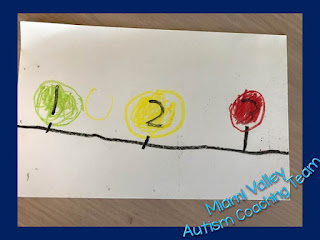Research
has shown that individuals with autism spectrum disorders demonstrate strength
in visual learning. In fact, they can process visual information up to 2X
faster than the neurotypical individual.
In contrast, research has shown that individuals with ASD take .4 to .9
seconds longer to process auditory information.
Visual supports make auditory information visual. In the classroom the
use of visual supports can significantly benefit your students. Visual supports supplement verbal
instruction, clarifying the information for the student and increasing
comprehension and therefore are an important component to planning engaging lessons for students with ASD. Today's Around Town Round Up has tons of great examples of instructional visual supports that we have seen across the Miami Valley.
Visual Supports for Math Instruction
Using consistent visual supports during math instruction help students understand expectations, provide communication options, and remind students of steps necessary for solving multi-step problems.
This visual support can be used for counting objects and selecting the corresponding number. The teacher has flexibility in providing a variety of objects while remaining consistent in how students respond which makes expectations more predictable.
 |
| Emily Ottmar Stevenson Elementary, Mad River Local Schools |
The visual support below provides students reminders for the steps that have been directly taught for telling time. Similar supports can be used for counting sets of coins, solving word problems, or calculating equations.
We love these great visuals for preschoolers to practice their graphing skills.
 |
| Darlene Hays and Andy Krickenbarger Anthony Wayne Preschool, Darke County ESC |
Visual Supports for Reading and Phonics Instruction
Using consistent visual supports during ELA instruction can make learning phonics and reading skills more hands-on and engaging. They can be used for a variety of skills including name sequencing, phonics, and reading comprehension.
This student can sequence flashcards on a velcro board or trace tactile letters for her name.
 |
| Deanna Mullins Kiser PK-8, Dayton Public Schools |
This team uses carpet squares to make velcro boards for their letter flashcards.
 |
| Casey Lathrop and Katie Bigelow Brookville Elementary, Brookville |
Students practice CVC segmenting and spelling skills using these visual supports.
 |
| Sandy Beck Broadway Elementary, Tipp City |
Ginny Dowd's Phonics Dance is found in many of the classrooms we visit. We love the unique ways teachers display their Phonics Dance visuals.
 |
| Kathy Timmerman Fairbrook Elementary, Beavercreek |
 |
| Mallory Normile Broadway Elementary, Tipp City |
These visual supports from Unique Learning System/News-2-You are excellent for providing communication options, illustrating vocabulary, and answering wh-questions about a monthly topic.
 |
| Jennifer McGowan Smith Middle School, Vandalia |
We love how picture symbols have been added to this word wall to help illustrate the sight words.
 |
| Toni Mallot Jane Chance Elementary, Miamisburg |
Visual supports are a great way to help students remember higher level concepts and content-related vocabulary.
 |
| Taylor Ruef Stevenson Elementary, Mad River Local Schools |
 |
| Megan Kelly Beavertown Elementary, Kettering |
Visual Supports for Writing Instruction
These reusable name boards are a quick and easy way for students to get daily practice on writing their name.
 |
| Darlene Hays and Andy Krickenbarger Anthony Wayne Preschool, Darke County ESC |
Visual supports can also be used for students who struggle with fine motor skills but continue to
 |
| Laurie Maravetz Schaefer Middle School, Springfield |
Rubrics are also a great visual support to help students understand expectations. Check out this great writing rubric using examples.
 |
| Megan Kelly Beavertown Elementary, Kettering |
Visual Supports for Science and Social Studies
Science and Social Studies concepts can often be difficult for our students to visualize. Using visual supports can make these concepts easier to understand and more engaging for students.
Visual supports can be used to illustrate I Can Statements.
 |
| Taylor Ruef Stevenson Elementary, Mad River Local Schools |
This teacher does a wonderful job of using a variety of visual supports for story illustrations, science concepts such as the food chain, and social studies concepts such as geography and map skills. What a great way to engage students in their learning!
 |
| Laurie Maravetz Schaefer Middle School, Springfield |
This group project combined art and used stickers and picture symbol labels as visual supports. What a wonderful way to display student learning!
 |
| Emily Ottmar Stevenson Elementary, Mad River Local Schools |
For more examples of wonderful visual supports check out our previous blog post for Supporting Content Instruction.







No comments:
Post a Comment